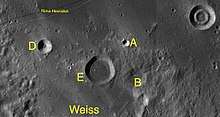Weiss (crater)
Weiss is a lunar impact crater along the southern edge of the Mare Nubium. It was named after Austrian astronomer Edmund Weiss.[1] Nearly attached to the southwest rim is the crater Cichus, and Pitatus lies just over one crater diameter to the east-northeast. To the east-southeast lies the eroded Wurzelbauer.
 Lunar Orbiter 4 image the top of the crater with the neighboring Cichus on the bottom left | |
| Coordinates | 31.8°S 19.5°W |
|---|---|
| Diameter | 66 km |
| Colongitude | 20° at sunrise |
| Eponym | Edmund Weiss |
The northern rim of this crater has been removed and the interior flooded by lava, leaving a nearly featureless surface. The southern half of the rim still survives, although it is eroded in places. This rim climbs to a height of 0.8 km above the base. The satellite crater Weiss E lies at the northern edge of the interior floor, along the surviving remnant of the rim edge. A smaller crater just to the east of Weiss E has incised the low rise along the northeastern side.
The crater is marked by traces of the ray system from the prominent crater Tycho, which lies several hundred kilometers to the southeast. To the north of Weiss is the rille designated Rima Hesiodus, named after the crater Hesiodus to the northeast.
Satellite craters

By convention these features are identified on lunar maps by placing the letter on the side of the crater midpoint that is closest to Weiss.
| Weiss | Latitude | Longitude | Diameter |
|---|---|---|---|
| A | 30.5° S | 18.6° W | 4 km |
| B | 31.2° S | 18.4° W | 10 km |
| D | 30.7° S | 20.3° W | 9 km |
| E | 31.1° S | 19.2° W | 17 km |
References
- "Weiss (crater)". Gazetteer of Planetary Nomenclature. USGS Astrogeology Research Program.
- Andersson, L. E.; Whitaker, E. A. (1982). NASA Catalogue of Lunar Nomenclature. NASA RP-1097.CS1 maint: ref=harv (link)
- Bussey, B.; Spudis, P. (2004). The Clementine Atlas of the Moon. New York: Cambridge University Press. ISBN 978-0-521-81528-4.CS1 maint: ref=harv (link)
- Cocks, Elijah E.; Cocks, Josiah C. (1995). Who's Who on the Moon: A Biographical Dictionary of Lunar Nomenclature. Tudor Publishers. ISBN 978-0-936389-27-1.CS1 maint: ref=harv (link)
- McDowell, Jonathan (July 15, 2007). "Lunar Nomenclature". Jonathan's Space Report. Retrieved 2007-10-24.CS1 maint: ref=harv (link)
- Menzel, D. H.; Minnaert, M.; Levin, B.; Dollfus, A.; Bell, B. (1971). "Report on Lunar Nomenclature by the Working Group of Commission 17 of the IAU". Space Science Reviews. 12 (2): 136–186. Bibcode:1971SSRv...12..136M. doi:10.1007/BF00171763.CS1 maint: ref=harv (link)
- Moore, Patrick (2001). On the Moon. Sterling Publishing Co. ISBN 978-0-304-35469-6.CS1 maint: ref=harv (link)
- Price, Fred W. (1988). The Moon Observer's Handbook. Cambridge University Press. ISBN 978-0-521-33500-3.CS1 maint: ref=harv (link)
- Rükl, Antonín (1990). Atlas of the Moon. Kalmbach Books. ISBN 978-0-913135-17-4.CS1 maint: ref=harv (link)
- Webb, Rev. T. W. (1962). Celestial Objects for Common Telescopes (6th revised ed.). Dover. ISBN 978-0-486-20917-3.CS1 maint: ref=harv (link)
- Whitaker, Ewen A. (1999). Mapping and Naming the Moon. Cambridge University Press. ISBN 978-0-521-62248-6.CS1 maint: ref=harv (link)
- Wlasuk, Peter T. (2000). Observing the Moon. Springer. ISBN 978-1-85233-193-1.CS1 maint: ref=harv (link)
| Wikimedia Commons has media related to Weiss (crater). |